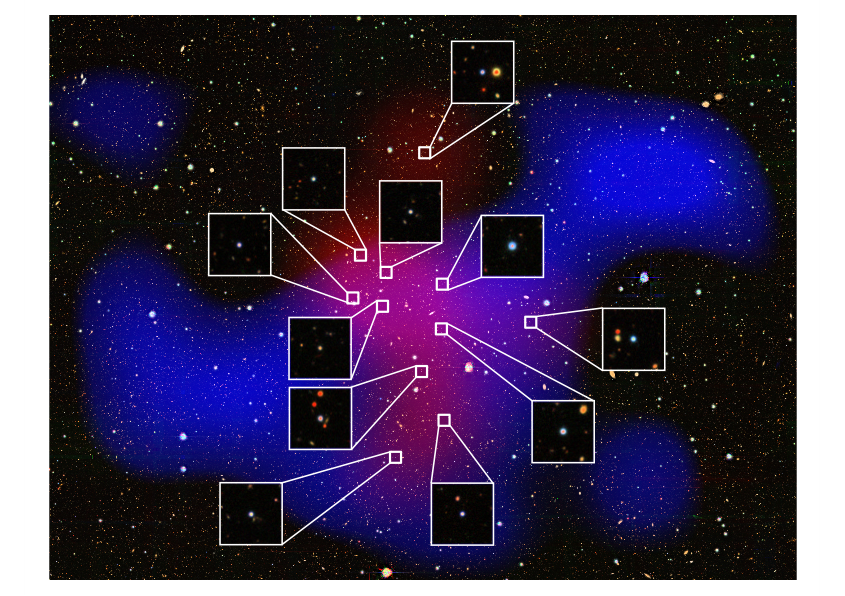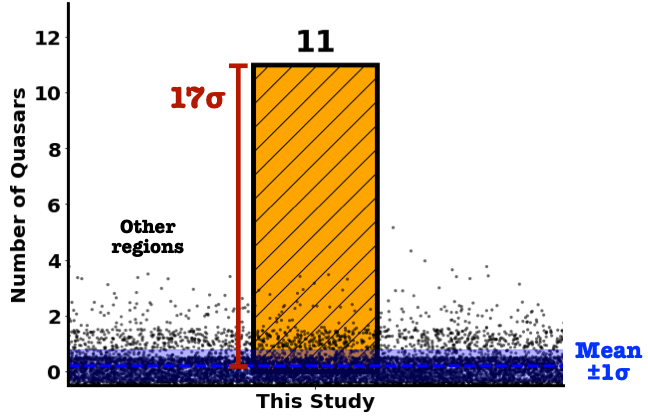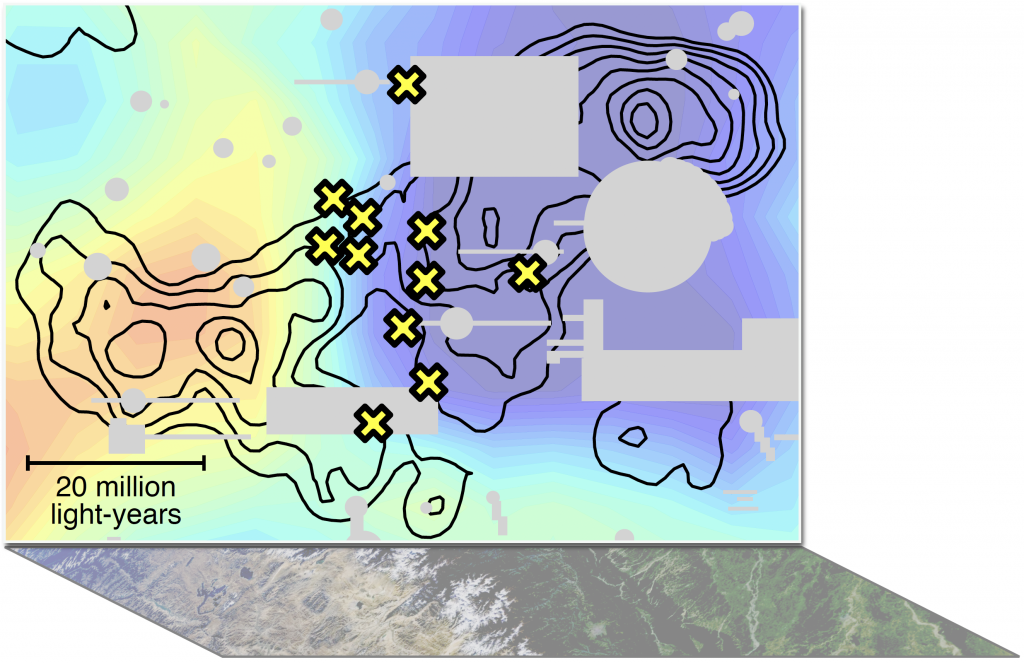An international team of astronomers has discovered a tightly packed cluster of supermassive black holes dating back 10.8 billion years―the most extreme concentration of such objects ever found in the Universe.Wide-field observations with the Subaru Telescope, combined with data from the Sloan Digital Sky Survey (SDSS), further revealed that these black holes lie along the boundary of dynamically evolving cosmic environments. The discovery challenges current ideas about where and how supermassive black holes grow during the ongoing structure formation in the early Universe.

A Giant Cluster of Supermassive Black Holes
Supermassive black holes, known as quasars, shine like cosmic beacons due to the vast amounts of energy released as they actively consume matter from their surroundings. Even in the early Universe, when quasar activity peaked, quasars remained sparsely distributed with typical separations of hundreds of millions of light-years. However, an international team of astronomers led by Dr. Yongming Liang of Subaru Telescope, NAOJ, has discovered 11 quasars packed into a region just 40 million light-years across―remarkably compact on cosmic scales.
“It’s the most extreme concentration ever found. The odds against quasars appearing this close together by random chance is one-in-ten–vigintillion (1064), a statistical anomaly known as a 17-sigmaoutlier. In simpler terms, this level of clustering is so improbable that it effectively rules out random coincidence,” says Dr. Liang (Figure 2).

The Subaru Telescope’s Role: Revealing Mysterious Galaxy Distribution
After this remarkable cluster of quasars was first spotted in the Sloan Digital Sky Survey (SDSS), the team conducted follow-up observations using Hyper Suprime-Cam (HSC) on the Subaru Telescope, to further investigate its nature. HSC offers a rare combination of an ultra-wide field of view — encompassing a region spanning 150 million light-years around these quasars — and the deep sensitivity of an 8.2-meter-class telescope. This enabled astronomers to detect hundreds of faint, young galaxies surrounding the quasar structure (Figure 1).
It is expected that supermassive black holes are more likely to become active in crowded regions of the Universe. In such dense environments, galaxies interact more frequently, like people brushing past each other in a busy carnival, and such interactions can send material spiraling toward the centers of galaxies. This material can fuel the growth of the central black holes, turning them into brilliant quasars. But the Subaru Telescope observations revealed a surprise: the quasars were not sitting inside the main galaxy clusters. Instead, they sat about 25 million light-years away. This discovery forces astronomers to reconsider where and how massive black holes grow.
“Without the Subaru Telescope’s imaging power, this spatial mismatch would have gone unnoticed,” says Dr. Liang.
A Growing Mystery in the Cosmic Gas Distribution
To further investigate this unusual cosmic landscape, the team mapped the three-dimensional distribution of cosmic gas between the galaxies. Curiously, the quasars did not lie within the densest gas regions, nor in the emptiest voids. Instead, they were positioned at the interface between neutral and ionized gas (Figure 3).
This configuration may reflect a transitional zone in the large-scale structure of the Universe, where two growing galaxy clusters are interacting or assembling along a thread-like structure of galaxies and gas known as a cosmic filament. Rather than marking a mature structure, the quasars could be tracing an intermediate phase of growth, where black holes, galaxies, and intergalactic gas are still evolving together. Their positioning suggests a dynamic environment shaped by both ongoing structure formation and feedback from quasar activity. Because of its towering concentration of quasars and its location at the boundary of evolving structures, the team named this formation the “Cosmic Himalayas.”

“We found that these quasars gather right along the edges of changing cosmic conditions,” says Dr. Liang. “This may indicate that their powerful radiation is actively reshaping the gas around them, while at the same time, they may be tracing regions where massive structures like galaxy clusters are still in the process of assembling. That’s why we named it the Cosmic Himalayas – it stands out like a mountain range separating distinct structures in the early Universe.”
“Finding such a concentration of active black holes – and discovering that their surrounding galaxy and gas distributions deviate from our conventional picture of the Universe – is truly astonishing,” says Professor Masami Ouchi, a member of the team. “It could be that we’ve simply found a uniquely special place in the cosmos. But it might also point to something deeper – perhaps we are witnessing a rare moment in cosmic history when many black holes become active all at once. Future studies will be essential in revealing the true nature of this discovery.”
Looking to the Future
This discovery highlights how combining large-scale sky surveys with high-quality imaging data from facilities like the Subaru Telescope can reveal previously unseen aspects of the Universe. Future projects, including Subaru Telescope’s next-generation instrument, the Prime Focus Spectrograph (PFS), are expected to further elucidate the cosmic puzzles uncovered by this approach and help us better understand how the Universe we see today came into being.
These results will be published as Liang et al. “Cosmic Himalayas: The Highest Quasar Density Peak Identified in a 10,000 deg2 Sky with Spatial Discrepancies between Galaxies, Quasars, and IGM HI” in the Astrophysical Journal on June 6, 2025. A preprint is available here.
〈DOI〉10.3847/1538-4357/adc1bb
〈URL〉https://iopscience.iop.org/article/10.3847/1538-4357/adc1bb
Notes:
(Note 1) Using data from the SDSS, the team mapped the hydrogen gas between galaxies by measuring how it absorbs light from background quasars. Like shining flashlights through fog, this technique, called intergalactic medium tomography, reveals the three-dimensional distribution of cosmic gas.
(Note2) the Subaru Telescope–The Subaru Telescope is a large optical-infrared telescope operated by the National Astronomical Observatory of Japan, National Institutes of Natural Sciences with the support of the MEXT Project to Promote Large Scientific Frontiers.





